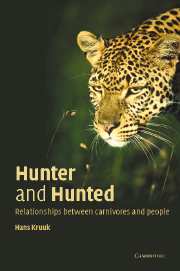Book contents
- Frontmatter
- Contents
- Preface
- 1 Turning the other cheek
- 2 Carnivore society: hermits and communes
- 3 The quarry of the hunter
- 4 Man the hunted
- 5 Competitors and carriers
- 6 History of a conflict
- 7 What is the use?
- 8 Wolves with human souls: pets
- 9 Carnivores and neighbours: effects on prey
- 10 Crying wolf: anti-predator behaviour
- 11 Carnivores in culture
- 12 The future
- Epilogue
- References
- Index
2 - Carnivore society: hermits and communes
Social systems, groups and territories
Published online by Cambridge University Press: 08 January 2010
- Frontmatter
- Contents
- Preface
- 1 Turning the other cheek
- 2 Carnivore society: hermits and communes
- 3 The quarry of the hunter
- 4 Man the hunted
- 5 Competitors and carriers
- 6 History of a conflict
- 7 What is the use?
- 8 Wolves with human souls: pets
- 9 Carnivores and neighbours: effects on prey
- 10 Crying wolf: anti-predator behaviour
- 11 Carnivores in culture
- 12 The future
- Epilogue
- References
- Index
Summary
Behavioural scientists, and probably all of us, are patently biased towards an interest in group-living carnivores, and they get much more attention than the solitary ones. Why is it that people are so taken by the way in which such societies of wild hunting predators are organized? Has it to do with these animals actually hunting in groups, or is it because they organize themselves in group territories and societies, or show other similarities to us? There are fascinating parallels between the societies of group-living carnivores and those of primates. Obviously, one has to be very careful in assigning evolutionary significance to such convergence, but it is at least likely that our interest in highly organized carnivore societies is fuelled by the apparent similarities with our own, or with those of our nearest relatives.
Years ago in the Ngorongoro Crater in Tanzania, I remember meeting up with Jane Goodall, who was taking a break from her work on chimpanzees, which she had recently started at Gombe Stream (Goodall 1971). I had been studying spotted hyaenas for some time there, and we eagerly swapped notes on our animals, discussing individuals and their social set-up. It was difficult not to get overenthusiastic, because there were so many analogies between my hyaenas and Jane's chimps. Most strikingly, both species live in a ‘fission—fusion society’, i.e. in large communities that have their own territory, but within which the members are not permanently together.
- Type
- Chapter
- Information
- Hunter and HuntedRelationships between Carnivores and People, pp. 21 - 40Publisher: Cambridge University PressPrint publication year: 2002

